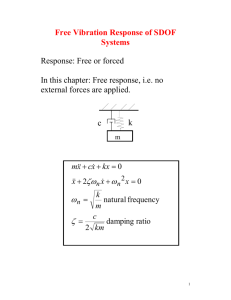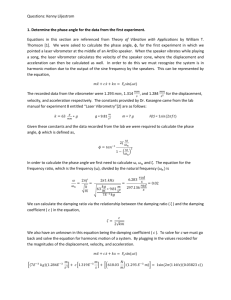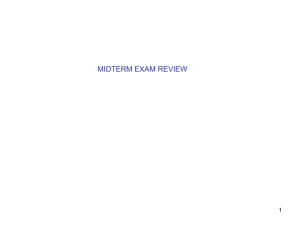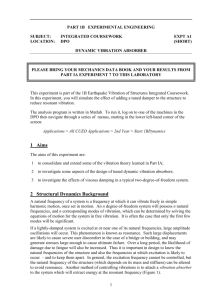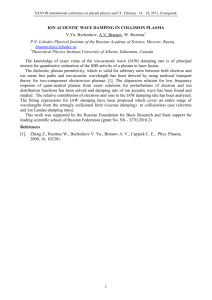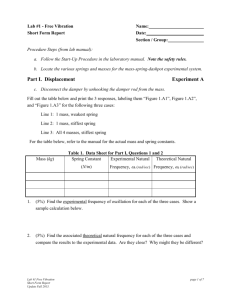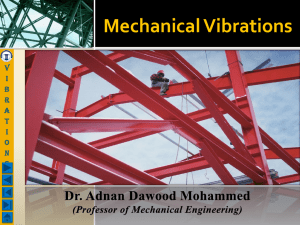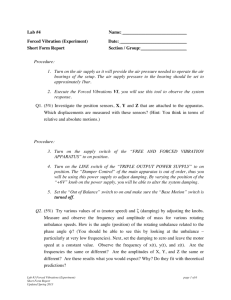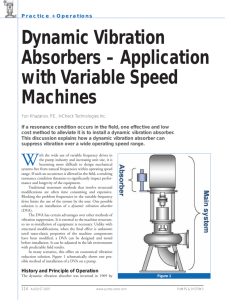Experiment A1 - Vibr..
advertisement
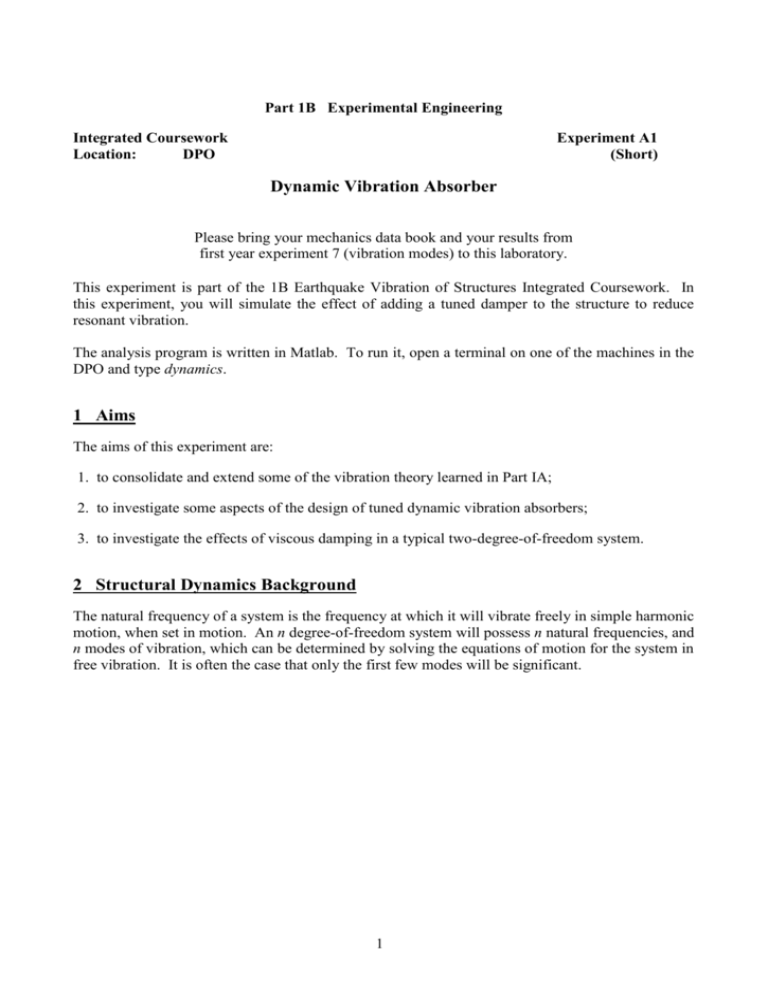
Part 1B Experimental Engineering Integrated Coursework Location: DPO Experiment A1 (Short) Dynamic Vibration Absorber Please bring your mechanics data book and your results from first year experiment 7 (vibration modes) to this laboratory. This experiment is part of the 1B Earthquake Vibration of Structures Integrated Coursework. In this experiment, you will simulate the effect of adding a tuned damper to the structure to reduce resonant vibration. The analysis program is written in Matlab. To run it, open a terminal on one of the machines in the DPO and type dynamics. 1 Aims The aims of this experiment are: 1. to consolidate and extend some of the vibration theory learned in Part IA; 2. to investigate some aspects of the design of tuned dynamic vibration absorbers; 3. to investigate the effects of viscous damping in a typical two-degree-of-freedom system. 2 Structural Dynamics Background The natural frequency of a system is the frequency at which it will vibrate freely in simple harmonic motion, when set in motion. An n degree-of-freedom system will possess n natural frequencies, and n modes of vibration, which can be determined by solving the equations of motion for the system in free vibration. It is often the case that only the first few modes will be significant. 1 Figure 1: Tuned Vibration Absorber – Taipei 101, Taiwan. This absorber is primarily to reduce windinduced motion. If a lightly-damped system is excited at or near one of its natural frequencies, large amplitude oscillations will occur. This phenomenon is known as resonance. Such large displacements are likely to cause severe user discomfort in the case of a building, and may generate stresses large enough to cause ultimate failure. Over a long period, the likelihood of damage due to fatigue will also be increased. Thus it is important in design to know both the natural frequencies of the structure and the frequencies at which excitation is likely to occur – and to keep them separate. In general, the excitation frequency cannot be controlled, but the natural frequency of the structure (which depends on its mass and stiffness) can be altered to avoid resonance. Another method of controlling vibrations is to attach a vibration absorber to the system which will extract energy at the resonant frequency. y= f k Structures are often idealised as simple systems for the purpose of analysis. The simplest of these is the single-degree-of-freedom (1DOF) spring-mass system shown in figure 2. In a static analysis, the displacement is simply given by Hooke’s Law, i.e. the static spring force is the only force resisting the loading. However, in a dynamic analysis, the loading and displacements vary with time and thus there are also forces due to acceleration. The problem can be expressed in an equation of motion relating inertial, damping, stiffness and loading forces (see Data Book): f m k m ÿ λ ẏ ky = f In the absence of damping, the equation of motion in free vibration is 2 Figure 2: 1DOF system y m ÿ ky= 0 which can be solved to give the undamped natural frequency, k ω n= m The natural period of the system is then T 0= 2π ωn In this situation, an initial perturbation will cause the system to oscillate with constant amplitude forever. The presence of damping is an energy-loss mechanism which causes the oscillations to die away over time. The damping rate is expressed in Ns/m. The size of the damping rate determines how fast the system will return to its equilibrium position following any perturbation (and for periodic forcing, higher damping rates reduce the oscillation amplitude at resonance). The critical damping rate crit is the smallest value of which inhibits oscillation (or “overshoot”) when the system is displaced and released, and can be defined as crit = 2mn The damping of a system can be expressed as a fraction of this critical value ζ= λ λ crit and the equation of motion can then be rewritten as ÿ 2ζ ẏ ω 2n ωn y= f =x k The presence of damping alters the natural frequency of the system; the damped natural frequency is given by ω d= ω n 1− ζ 2 A frequency response graph for a structure is a curve showing the amplitude of response at a range of forcing frequencies, with a peak occurring at the natural frequency. The half-power bandwidth is the width of the peak at a level 1/ 2 times the maximum amplitude, and is a characteristic which can be used to describe the amount of damping in the system. The Mechanics Data Book gives expressions for both the response amplitude at resonance and the half-power bandwidth for a 1DOF system. Such simple expressions are not available for multi-degree-of-freedom systems, but the Figure 3: Tuned vibration analysis can be easily carried out with the computer program absorber on the model structure provided. 3 3 Introduction to the experiment Last year, you looked at the response of a model building to a vibrating input force. In a full-size building, vibration causes problems of discomfort, damage and possible collapse, so it is important to look at ways to reduce it. In this experiment, you will use a computer model of this building to investigate the effect of a tuned vibration absorber. Such an item can be used on a full-size building to modify the behaviour of the structure – typically, it is used to reduce the response of the structure at resonance. As well as reducing motion in an earthquake, such systems can be used to reduce acoustic vibration, or wind-induced movement. The computer program used in this experiment allows systems of one or two degrees of freedom to be analysed. The left set of controls is used to run a harmonic response – this is the response that the system will produce if subjected to a sine wave over a long time period and allowed to stabilise into a steady state. The transient response is the response of the system under the application of a step force – this is a transient response that dies away over time, as the system settles into its new, stationary steady state. Figure 4: Screenshot of the main program window 4 Single Degree-of-freedom analysis Although this system has 3 degrees of freedom, we will look at each mode separately. As this is a linear system, these results may be added together to find the complete response of the system. 4 First, we will study the fundamental (lowest frequency) mode of the structure on its own, (i.e. without the addition of an absorber). This may be modelled as an equivalent mass-spring-dashpot combination as shown in figure 2. Using the measured mass of a floor of the structure, calculate the equivalent stiffness for vibration in the first resonant mode as measured in the 1A lab. You will need to know the undamped natural frequency for the structure – as damping is light, this will be approximately the same as the resonant frequency (the damped natural frequency, which you measured in first year experiment 7). m = 1.79 kg = 8 Ns/m k = ........ N/m These values will enable you to use information in the Mechanics Data Book to check some of the results you will obtain from the computer program. (In practice, it is always advisable where possible to use some hand calculations to verify the output from a computer.) The mass is the same as that measured for the structure in the 1A lab; the damping rate is measured from by matching the predicted curve to that measured on the structure. 4.1 Harmonic response: frequency analysis A model earthquake is simulated by applying a sinusoidal force to the structure, at ground floor level (as in experiment 7 last year). We would like to investigate the response of the building in the first mode. For this experiment, the input force will be modelled by a sinusoidal input force. Although this is perhaps not a realistic model of an earthquake, it allows a useful analysis of the building's response, which can later be extended. Use your results from last year to select a suitable range of frequencies to analyse (remember, we are looking at the response of the structure in the first vibration mode). Pick a typical input force for the structure – how much force it takes to produce a displacement of around 5 mm at the first floor, for example. 5 Find and record the frequency of the peak response and the peak displacement amplitude calculated by the program, and compare these with the results from the Data Book and your measured results from last year. Using the ‘zoom’ facility in the program, find the half-power bandwidth of the harmonic response and compare this with the Data Book result. Enter your results in the table below. Frequency of peak Amplitude of peak Half power (Hz) (m) bandwidth (Hz) Measured results Results using Data Book formulae Results using computer program What is the main source of error in the computer program? ............................................................................................................................................. ............................................................................................................................................. ............................................................................................................................................. ............................................................................................................................................. How does the order of magnitude of this error compare to that of the assumed mass-spring-damper model? ............................................................................................................................................. ............................................................................................................................................. ............................................................................................................................................. ............................................................................................................................................. 4.2 Transient response: time analysis Figure 5: Tuned absorber to be used on the model structure 6 We would also like to look at the response of the structure to a step input force. This produces a transient response in the structure (as opposed to the steady-state response to a continuous sine wave). It is also imaginable that this is a more realistic model of an earthquake (possibly!). Carry out an analysis with a step input force of the same magnitude as you used in the previous section. Describe the shape of the output response: ............................................................................................................................................. ............................................................................................................................................. ............................................................................................................................................. ............................................................................................................................................. 5 Two Degree-of-Freedom Analysis Absorber m2 5.1 Optimising the absorber damping Now consider the addition of a tuned absorber to the model building. This is shown in idealised form in figure 6 (a photograph of the absorber used on the model structure is shown in figure 5). The moving mass (m2) of the absorber is approximately 0.1 kg. k2 f Structure m1 k1 y First, calculate the appropriate spring constant k2 such that the absorber is ’tuned’ (recall from Part 1A, that this requires the undamped natural frequency of the absorber in isolation to be the same as the frequency of the troublesome Figure 6: 2DOF system resonance it is being used to eliminate.) k2 = ............................ Now investigate the effect of changing the damping Figure 7: A Stockbridge damper, used to reduce vibration of overhead power rate 2 of the absorber over a range of frequencies. lines For each damping rate considered, you should run both the frequency analysis (i.e. with a harmonic input) and the time analysis (with a step input). The frequency analysis allows you to identify the peak harmonic response of both the building and the absorber to harmonic forcing; the time analysis allows you to identify how long the transient response of the building and the absorber takes to die away. Make sure you apply the force to the building, and not to the absorber – also note that you have to specify a one or two degree of freedom analysis. 7 For the case of 2 = 100 Ns/m, the dashpot can be approximated as a rigid link. Use this “lumped mass” assumption to estimate the frequency and magnitude of the peak response using the Data Book formulae, and compare this with the computer solution. Damping (2) = 100 Ns/m Frequency of peak (Hz) Amplitude of peak (m) Results using Data Book formulae Results using computer program Now investigate the harmonic and transient responses of the building with the absorber fitted, for a range of dashpot rates 2. You already have the results for 2 = 100 Ns/m so try the other extreme value of 2 = 0.01 Ns/m. Next, try a broad range of values between these two extremes, trying to identify damping values where you get a reduction in the response of the structure. In the neighbourhood of these values, try a narrower range of damping values to identify the optimum value – that is, the one which gives (i) the minimum value of peak harmonic response of the building and (ii) a fast decay of the step response of the building. Write your results in the table below and plot a graph of the peak harmonic response of the building as a function of damping, using the graph paper at the end of this handout. When plotting, note that the graph uses a log scale and take care to select values of 2 which adequately cover this scale. The time for the response to decay completely is theoretically infinite – a practical alternative is to calculate the limits of an envelope which covers 10% of the equilibrium response at either side of this value, and identify the time taken for the response to enter this envelope and not leave it again (as may happen when modulation occurs). Any decay time longer than 30s is of no interest, so there is no need to record times once they exceed this. Damping, Ns/m Peak harmonic response of building m Peak harmonic response of absorber m Time for building response to decay to within 10% of the equilibrium position 1. What damping rate do you recommend for the dynamic absorber? ............................................................................................................................................. 2. Give a measure of the effectiveness of a dynamic vibration absorber which uses the damping rate you have recommended: 8 ............................................................................................................................................. ............................................................................................................................................. ............................................................................................................................................. ............................................................................................................................................. 3. Explain the reason for the ‘modulation’ of the time response: ............................................................................................................................................. ............................................................................................................................................. ............................................................................................................................................. ............................................................................................................................................. ............................................................................................................................................. 4. Sketch and explain the shape of the frequency response graph: Low damping Optimal damping High damping Low damping....................................................................................................................... ............................................................................................................................................. ............................................................................................................................................. Optimal damping.................................................................................. .............................................................................................................. .............................................................................................................. .............................................................................................................. High damping ...................................................................................... .............................................................................................................. .............................................................................................................. 9 Figure 8: A tuned absorber on a wine glass (see http://www2.eng.cam .ac.uk/~hemh/tmd.htm) .............................................................................................................. .............................................................................................................. 5. Sketch and explain the shape of the time response graph: Low damping Optimal damping High damping Low damping....................................................................................................................... ............................................................................................................................................. ............................................................................................................................................. ............................................................................................................................................. Optimal damping................................................................................................................. ............................................................................................................................................. ............................................................................................................................................. ............................................................................................................................................. High damping...................................................................................................................... ............................................................................................................................................. ............................................................................................................................................. ............................................................................................................................................. 6. Can you think of a way to improve the effectiveness of the dynamic vibration absorber? 10 ............................................................................................................................................. ............................................................................................................................................. ............................................................................................................................................. ALJ / DC / JW September 2006 (revised) AR / HEMH August 2007 (revised) 11 12
